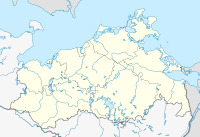Schlavenkensee nature reserve
Coordinates: 53 ° 25 '22.2 " N , 13 ° 23' 58.3" E
The Schlavenkensee nature reserve is a 610 hectare nature reserve in the east of Mecklenburg, northwest of Bredenfelde . It was placed under protection on July 7, 1993.
Purpose of protection and location
As in the Hinrichshagen nature reserve 4 km to the east, the protection purpose of this larger contiguous forest area consists in the preservation of tree populations of red beech and alder as well as stored forest-free moors, lakes and söllen, which represent a valuable habitat for threatened large bird species and the otter. Two lakes - the eponymous Schlavenkensee and the Havekensee - as well as open areas around the Hagenberg and the Bredenfelder Mühle are also part of the nature reserve. The nature reserve is located in the Feldberger Seenlandschaft nature park and is classified under EU law as an FFH area of the same name and also designated as a bird sanctuary . The current state of the area is considered to be good. The lack of disruption in the areas has a positive effect. A hiking and cycling path crosses the areas and provides insights.
history
The areas lie in a ground moraine landscape that was created in the last Ice Age . Traces of human settlement are documented by a barrow north of the Schlavenkensee since the Bronze Age . Remains of an old Slavic castle can be found in the western part of the area. The Schmettausche map from 1780 already shows the current tree line, so that an old forest area can be assumed in which no extensive clear-cutting has taken place since the post-glacial immigration of trees. The area was criss-crossed with numerous ditches, which had a strong impact on the areas. A watermill was operated in the eastern part of today's protected area . The forests are used for forestry today. You can fish and fish in the Schlavenkensee.
Flora and fauna
The main tree species in the wooded part of the protected area are red beech and black alder . Wood anemones , larkspur and liverworts cover the ground in spring . There are also swamp moors with alder and ash trees and kettle moors with peat moss . The two eutrophic lakes are lined with reeds . The yellow pond rose occurs. The lakes are surrounded by a ring of alder forest. Numerous birds of prey breed in the area, including sea eagles and spotted eagles , red and black kites , wasp and common buzzards as well as sparrowhawks and goshawks . Furthermore black stork , wood sandpiper , miniature flycatcher , black and middle woodpecker as well as the stock dove occur. The majority of these species are endangered and tied to old wood. Furthermore were Schellente , Kingfisher , Grebe , throttle and Teichrohrsänger detected. Otters and dormice also live in the area.
See also
literature
- Lake 268 . In: Ministry of Environment Mecklenburg-Western Pomerania (Hrsg.): The nature reserves in Mecklenburg-Western Pomerania . Demmler-Verlag, Schwerin 2003, ISBN 3-910150-52-7 , p. 354 f .
Web links
Individual evidence
- ↑ Standard data sheet FFH area Schlavenkensee (PDF; 54 kB)
- ↑ Standard data sheet EU bird sanctuary Feldberger Seenlandschaft and parts of the Woldegker hill country (PDF; 99 kB)
- ^ Loitz tumulus. In: Kleks-online.de. Retrieved January 30, 2013 .
- ↑ Quadenschönfeld castle wall. In: Kleks-online.de. Retrieved January 30, 2013 .
- ↑ Bredenfelde watermill. In: Kleks-online.de. Retrieved January 30, 2013 .




